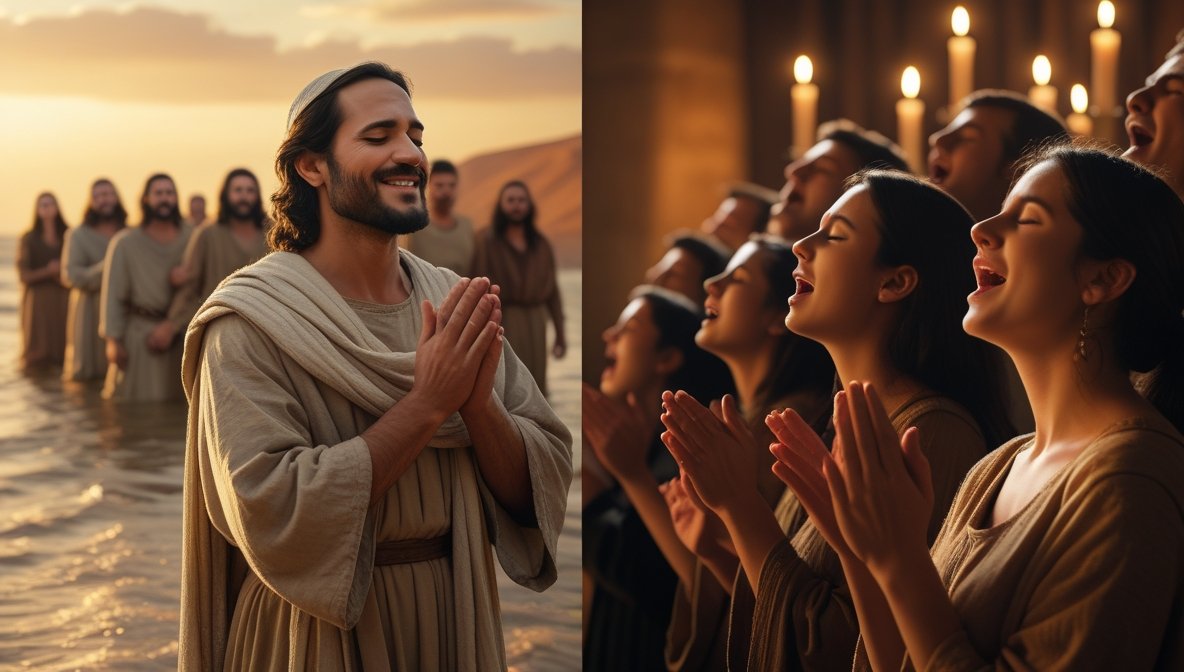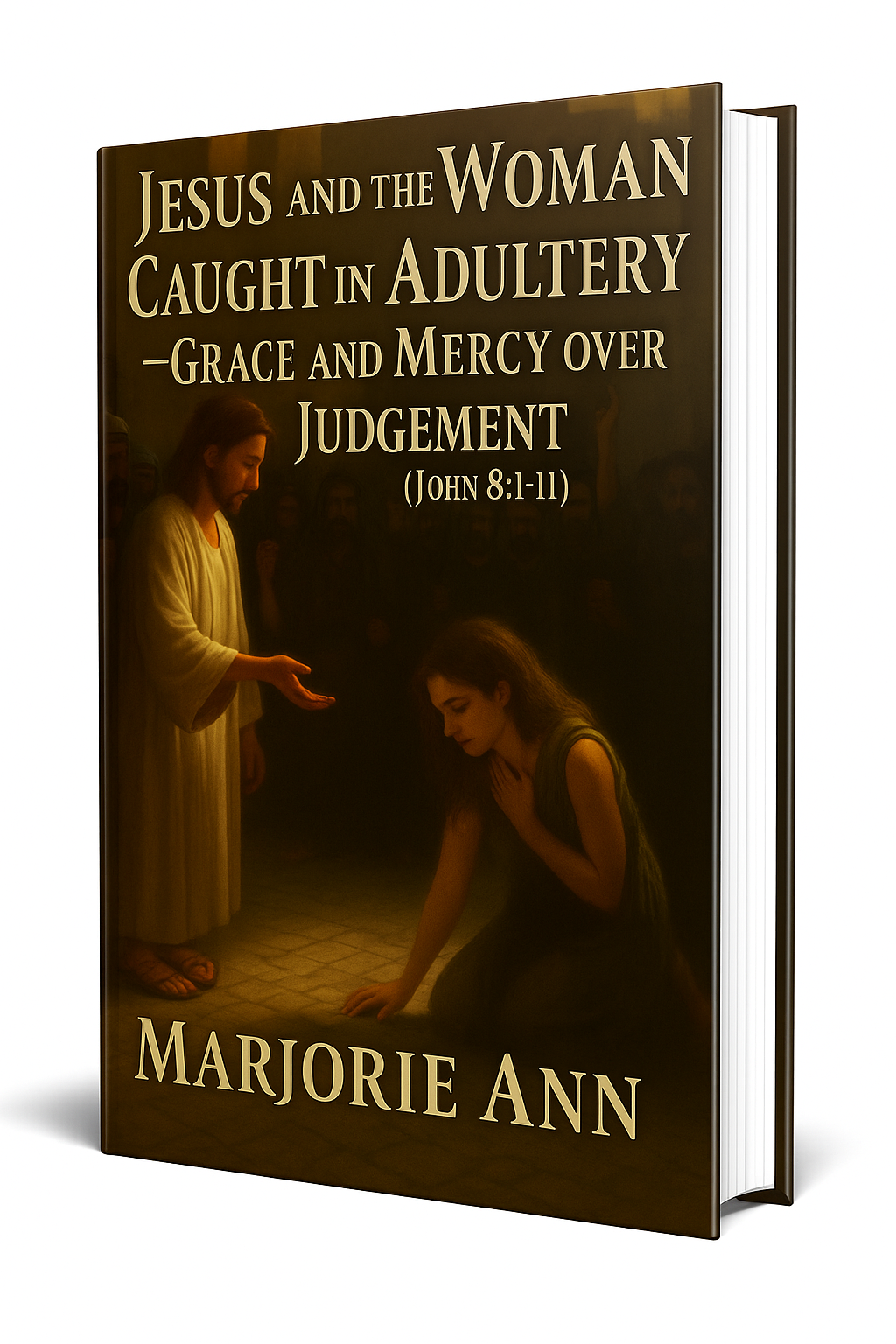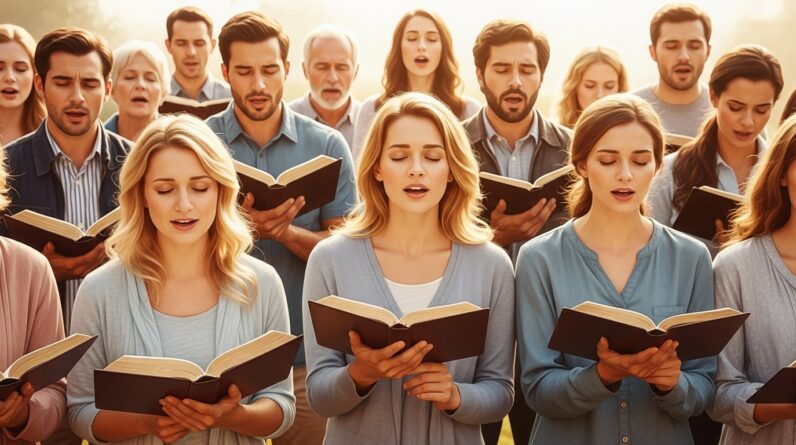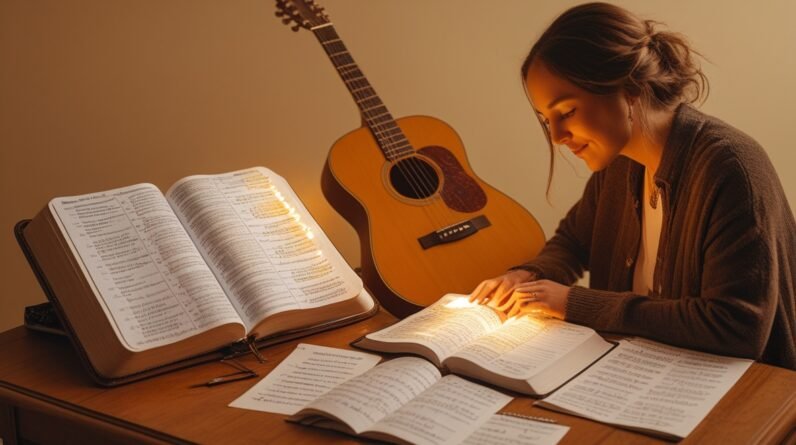Songs In The Bible: From Moses To The Early Church
You’ll notice, if you read the Bible with a kind of attention that isn’t rushed, that song appears almost everywhere. It’s not ornamental. It’s part of how people talk to God, how they remember, how they teach children what matters. This piece traces those moments — from the roar of the Red Sea turned into melody in Exodus, to the final canticles that close Revelation — and tries to show how those ancient utterances shape what you call worship now. Along the way, you’ll meet prophets who sing, mothers who compose prayers like poems, martyrs, and communities who sing in exile and in victory. The aim isn’t encyclopedic; it’s conversational, because these songs weren’t meant to be dissected on a lab bench. They were meant to be sung, remembered, and lived.
Why song matters in biblical communities
When you think about why a song matters to a community, think about memory. You can lecture someone. You can read a law and expect them to obey. But a song sticks. In the Bible, songs are mnemonic devices, liturgies, protest, theology, and sometimes a political manifesto. They compress the story into melody; they make theology portable. When the Israelites sang after the sea closed over Pharaoh’s army, they weren’t composing a victory lyric for propaganda’s sake — they were ensuring that the memory of God’s act of salvation would not fade: it would lodge in bodies and in tongues. The impulse to sing is social. Songs shape communal identity; they teach future generations who they are because they teach you what to remember.
The language of performance and memory
Singing creates a different kind of attention than reading. In song, phrases repeat; cadences etch themselves into your muscle memory. That’s practical: in societies with limited literacy, song is how law, history, and theology become collective knowledge. It’s also theological: to sing is to participate. You’re not just being told what happened; you are carrying it forward. So when you study the songs in the Bible, you’re tracing a thread of communal memory, a string of refrains that bind disparate moments into a single people.
The Song of Moses: Exodus 15
After the Red Sea incident, the community’s immediate response is music. Moses and the Israelites sing what the text calls the “Song of Moses.” It’s both a public proclamation and a personal testimony: “I will sing to the Lord, for he has triumphed gloriously” (Exodus 15:1–18). Read it and you hear the mixture of awe, fear, and triumph — the theological content is simple and dense: God fights, God saves, God is majestic. The song doesn’t stop at celebration; it frames the historical act as an event with theological meaning.
Read the text for yourself: Exodus 15:1-18.
What that song does for a people
Think about what it means for a newly freed people to sing. Their freedom is not simply political; it’s existential. The song codifies their identity: they were slaves, and now they are people called by God. The verses insist on remembrance and warning at once. This is why, centuries later, the memory of that song reappears in Revelation, where the image of the redeemed singing echoes the same content: deliverance and God’s justice.
Moses’ final song: Deuteronomy 32
Near the end of Moses’ life, he teaches the people a song that is meant to be a witness against them should they forget. Deuteronomy 32 reads like scripture composed to jar memory awake, a legal-poetic summation of history and a sharp prophetic indictment. It’s not celebratory in the same register as Exodus 15; rather, it is didactic, stern, and intentional.
You can read it here: Deuteronomy 32:1-43.
Songs as testimony and law
This song demonstrates another use of song in the Bible: it’s a tool for instruction, a legal testimony embedded in poetic form. Moses assumes that the people will sing this in the future; the song becomes a legal witness against communal forgetfulness. That dual character — liturgical and juridical — is part of why songs in the Bible function so powerfully: they carry moral content and are designed to be remembered.
Deborah’s song: Judges 5
In Judges 5, you find a striking female-voiced song, the Song of Deborah. This is the kind of text that reads like an eyewitness epic, a compressed national poem that recounts battle but also frames the event theologically. There’s praise and lament and a geography lesson all at once; the song names the tribes that fought and those that did not, and it exposes political failure.
Read it here: Judges 5:1-31.
Female voice and communal memory
Deborah’s song shows you that the song is also a medium of political critique. Songs in the Bible aren’t always about triumph. Sometimes they call out failure, they shame those who failed to act, they insist the community remember who did what and why. The song is woven into public life: it’s not private poetry meant only for the elite; it’s civic speech.

Hannah’s Song and the rise of thanksgiving
Hannah’s prayer in 1 Samuel 2 is a short but potent song of thanksgiving. After years of barrenness, she offers a stretched, theological hymn that celebrates reversal: the proud are scattered, the hungry are filled. The language is strikingly similar to later Magnificat themes, and the song reads like prophecy and praise intertwined.
Read Hannah’s song: 1 Samuel 2:1-10.
Songs as prophetic utterance
Hannah’s short hymn is prophetic because it reads social reversal as God’s justice. The song doesn’t just thank; it interprets history through a moral lens. That’s a persistent function of songs in the Bible: they interpret events on behalf of a community and they often imagine the world God is bringing into being.
David’s songs and the Psalter tradition
David is the iconic singer-king, the one you probably imagine with a harp. His songs range from laments to triumphant thanksgiving, from penitential cries to royal acclamations. 2 Samuel 22 is a victory song that closely parallels Psalm 18, and both point to the way personal testimony and public worship intersect. The book that follows, Psalms, becomes the long archive of Israel’s sung life.
Read David’s victory song: 2 Samuel 22:1-51 and its parallel: Psalm 18:1-50.
The Psalms: a songbook for a people
The Psalms function as a repertoire: laments for days of sorrow, hymns for days of celebration, wisdom songs, royal songs, and pilgrim songs. When you look at the Psalms, you’re looking at a communal hymnbook that shaped temple life, private devotion, and liturgy. The psalter’s variety tells you that worship involves grief as much as praise; God is the subject of every register.
Key Psalms that shaped worship
Some Psalms became especially influential in liturgy. Psalm 23 comforts the wandering, Psalm 95 calls the people to worship in a gathered way, and Psalm 150 catalogues instruments and the exuberance of praise. These texts are more than poetry; they are liturgical instructions for how to praise: with trumpet, harp, lyre, and dance.
Read these Psalms: Psalm 23:1-6, Psalm 95:1-7, Psalm 150:1-6.
How the Psalms formed corporate imagination
The psalms are not merely personal devotions; they train you to inhabit a communal imagination. Singing Psalm 23 in a group is not just private consolation; it’s a public claim that God shepherds the collective. That’s why songs in the Bible have stayed relevant — they’re not simply artifacts but tools that form a people’s inner life.
Isaiah and prophetic hymns
Prophets occasionally sing too. Isaiah 12 is a short hymn of thanksgiving that reads almost like a response piece to earlier promises of redemption. When you read Isaiah 12, you meet a people moved to sing because God’s saving action has been declared. The prophetic voice often slips into poetry and song because prophecy itself is performative: it’s a word that does something.
Read Isaiah’s hymn: Isaiah 12:1-6.
Habakkuk: a prayer-song in crisis
Habakkuk 3 is striking: it’s a prayer in the form of a song, recounting God’s past deeds and affirming trust in the midst of fear. The prophet imagines God’s theophany as a dramatic, almost martial arrival, and then repeats a line of sober trust: “Yet I will rejoice in the Lord; I will take joy in the God of my salvation.” Read it as a song that teaches endurance.
Read Habakkuk’s canticle: Habakkuk 3:1-19.
The Magnificat and Benedictus: songs at the beginning of the New Testament story
Luke’s infancy narrative is saturated with song. Mary’s Magnificat and Zechariah’s Benedictus read like continuations of the prophetic-song tradition, but they are also deeply personal. Mary’s song (Luke 1:46-55) is filled with themes of reversal — the humble lifted and the proud scattered — and it echoes Hannah and the Psalms. Zechariah’s Benedictus (Luke 1:68-79) is oriented toward the coming redemption and the preparation of a people for the Lord.
Read them here: Luke 1:46-55 and Luke 1:68-79.
Songs that root new beginnings in old promises
When Mary sings, she is intentionally placing a new event within the continuity of Israel’s story. That’s why the songs in the Bible matter: they link moments across history. Mary’s and Zechariah’s songs show you how the early Christian imagination read its identity back into Israel’s tradition. The songs become the bridge.
Simeon and the Nunc Dimittis
Simeon’s brief song at the temple (Luke 2:29–32) is a distinct kind of canticle: it’s a benediction, a recognition of fulfillment. “My eyes have seen your salvation” — that sentence summarizes a lifetime of waiting. It’s the kind of short, sharp song that makes you feel the end of waiting as both personal and communal.
Read Simeon’s words: Luke 2:29-32.
Small songs that mark epiphanies
Not every biblical song is long. Some are small, almost liturgical refrains, but their function is the same: they mark turning points. You can think of these smaller songs as liturgical punctuation — brief but decisive claims about God’s action.
Jesus and song: the Last Supper hymn
There’s a short note in the Gospels that after the last supper, Jesus and his disciples sang a hymn. Mark records it succinctly: “When they had sung a hymn, they went out to the Mount of Olives” (Mark 14:26). It’s a small detail that hints at how Jesus used the liturgical repertoire of his people — the psalms — in moments of communal significance. The hymn probably came from the Hallel (Psalms 113–118) sung at Passover.
See the Gospel note: Mark 14:26.
Song as a company in crisis
That brief mention of a hymn at such a tense moment is telling: song is not only for triumph. It’s also the language for farewells, for solidarity, for facing suffering together. The act of singing binds you to others; it anchors courage and memory.
The early church’s songbook: Revelation’s visions
The book of Revelation fills its apocalyptic canvases with songs. Worship in John’s vision is sung, layered, and communal. In Revelation 4–5 you have angelic and human hymns praising God and the Lamb. The imagery culminates in the final trilogy of songs in Revelation 15, where a “song of Moses” is sung again alongside a song of the Lamb — a deliberate linking of Israel’s ancient song tradition to the Christian vision of redemption.
Read Revelation’s hymns: Revelation 4:8-11, Revelation 5:9-14, and the climactic: Revelation 15:1-4.
Continuity: the Song of Moses and the Lamb
The fact that Revelation includes a “song of Moses” next to a song of the Lamb is not accidental. The author wants you to hear a continuity: the God who saved Israel is the same God who redeems creation in John’s apocalyptic vision. That continuity explains why the early church kept singing old psalms and why the psalter remained so central to Christian worship. The songs in the Bible are not discrete artifacts but a woven tradition.

Functions of biblical songs: praise, lament, teaching, prophecy
If you catalog the songs, patterns emerge. Some songs praise — they extol God’s attributes and deeds. Some lament — they cry out in pain and ask for deliverance. Some teach — like Moses’ song in Deuteronomy — carrying law and memory. Some prophesy — imagining a future reversal or a divine act of justice. All functions reinforce the idea that song is a theological medium. When you sing, you’re not simply expressing emotion; you’re making doctrinal claims about God and the world.
The theological weight of melody
Melody gives doctrine a body. A theological claim delivered in a sermon may be persuasive; delivered in song, it lodges in the membrane of a community’s life. You learn to trust by singing the affirmations of faith; you learn lament language by singing the laments. This is why the psalter shaped both private devotion and public creed.
Musical forms and performance practices
We don’t have recordings of ancient Israel, obviously, but the text provides clues about how songs were performed. Some psalms are marked “with stringed instruments,” others “a contemplation of David,” and some indicate antiphonal or call-and-response forms. The instruments named — lyres, harps, cymbals, trumpets — suggest a rich sonic life. Psalm 150 reads like a catalog of instruments: “Praise him with the sounding of the trumpet, praise him with the harp and lyre” (Psalm 150:3-5).
Read Psalm 150 here: Psalm 150:1-6.
Responsorial and antiphonal singing
Some scholars think that Israel used responsorial singing, where a leader’s line is answered by the congregation. That form is practical and communal, and it’s the form you still hear in many liturgical traditions. It democratizes the act of worship: song is participatory rather than merely performed.
How ancient songs inform modern worship
If you lead worship or simply attend, you should notice that many modern practices are heirs to this biblical tradition. Contemporary worship often borrows themes from psalms: praise, confession, and lament. Hymnody in Protestant traditions often paraphrases psalms; Catholic liturgies still sing the psalter. Even modern worship bands that play electric guitars are participating in a long lineage that uses melody to teach theology and shape communal memory.
When you sing “songs in the bible” or songs inspired by them, you’re in literal conversation with ancient voices that thought melody could carry truth. That’s not nostalgia; it’s continuity. The theological content is adapted, of course, to new languages and cultural idioms, but the function remains: songs teach, form, and remember.
Practical ways to recover biblical song practices
If you’re interested in bringing biblical song practices into your context, start small. Introduce a psalm into your gathering as a communal recitation or chant. Try a responsorial form where one voice leads and the community answers. Consider the content: Psalms often include lament — make space for that. Use instruments thoughtfully: Psalm 150 invites celebration with sound, but not everything calls for exuberance. The key is intentionality: choose songs that form the theological habits you want your community to develop.
The social role of song: identity, protest and resilience
Consider how songs in the Bible often name who the people are amid a crisis. Songs can be subversive. Deborah’s Song names the tribes who failed to act; Hannah’s song privileges the lowly; Mary sings of reversal. Songs provide a vocabulary for protest and a grammar for resilience. When people are displaced or persecuted, songs become a place where identity is reheated and affirmed.
Songs as scandal and consolation
Songs can scandalize because they proclaim God’s justice where human systems fail. They console because they place sufferers within a broader story. In exile or in triumph, song is how identity survives.
Bringing biblical songs into your life now
If you want to let these texts shape your life, you don’t have to become an academic or a liturgist. Start with the psalms: pick a psalm a week and learn its contours. Try singing it out loud, even if you’re alone in your kitchen. Invite others to sing brief refrains at the start of gatherings. Learn a short hymn that is a direct paraphrase of a psalm. When you’re grieving, read aloud the laments: they teach you the language of grief and the possibility of trust.
Practical steps
- Choose one psalm a week and read it twice: once aloud, once silently. Notice the verbs, the shifts from lament to praise.
- Try a short chant or repeated phrase in corporate settings — a refrain that the entire group can pick up.
- When teaching, use sung refrains to memorize key truths. Songs in the Bible were mnemonic — use them that way.
- Don’t shy away from lament. Model it. Teach your community to sing its sorrow honestly.
Conclusion: Why the thread matters
Tracing songs from Moses to the early church, you notice a thread: these are not decorative additions to religious life; they are the way the people of God make theology audible. From Exodus 15’s surfacing of deliverance to Revelation 15’s final “song of Moses and the Lamb,” the biblical narrative insists that to be God’s people is to sing. Those songs in the bible — the prophetic hymns, the psalms, the canticles — are repositories of memory, tools for instruction, and instruments of communal identity. Singing re-members you. It reattaches your future to a past that insists on God’s action and promise.
Explore More
For further reading and encouragement, check out these posts:
👉 7 Bible Verses About Faith in Hard Times
👉 Job’s Faith: What We Can Learn From His Trials
👉 How To Trust God When Everything Falls Apart
👉 Why God Allows Suffering – A Biblical Perspective
👉 Faith Over Fear: How To Stand Strong In Uncertain Seasons
👉 How To Encourage Someone Struggling With Their Faith
👉 5 Prayers for Strength When You’re Feeling Weak

📘 Jesus and the Woman Caught in Adultery – Grace and Mercy Over Judgement
A powerful retelling of John 8:1-11. This book brings to life the depth of forgiveness, mercy, and God’s unwavering love.
👉 Check it now on Amazon
As a ClickBank Affiliate, I earn from qualifying purchases.
Acknowledgment: All Bible verses referenced in this article were accessed via Bible Gateway (or Bible Hub).
“Want to explore more? Check out our latest post on Why Jesus? and discover the life-changing truth of the Gospel!”








